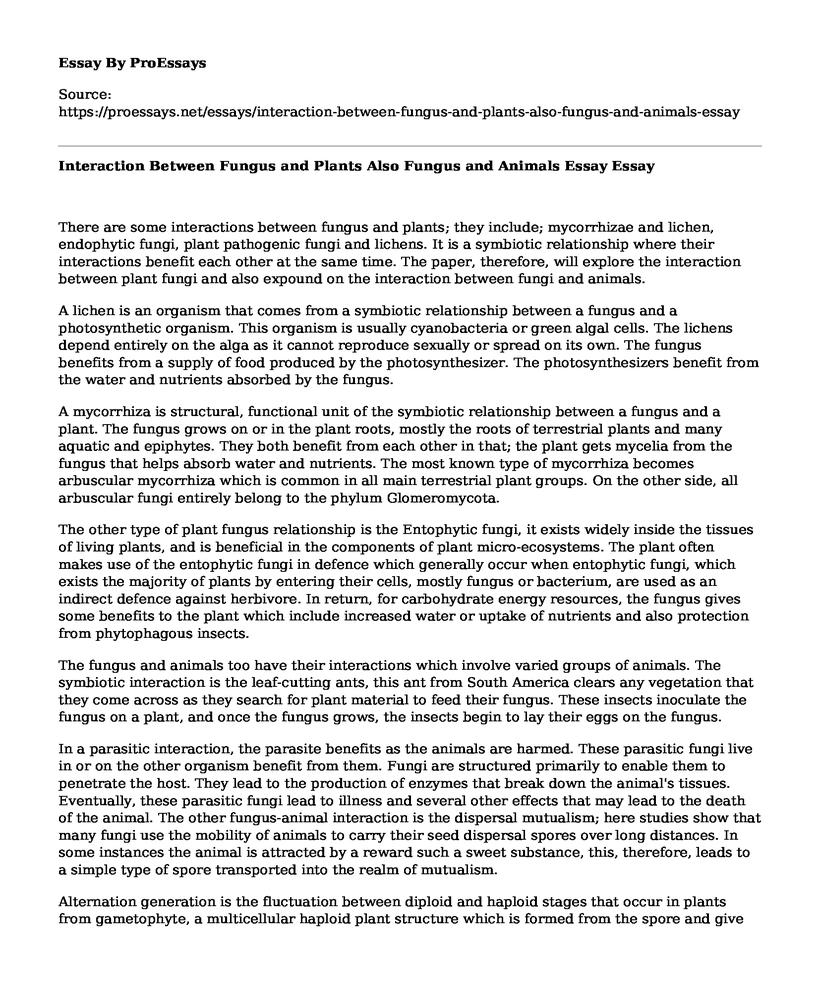There are some interactions between fungus and plants; they include; mycorrhizae and lichen, endophytic fungi, plant pathogenic fungi and lichens. It is a symbiotic relationship where their interactions benefit each other at the same time. The paper, therefore, will explore the interaction between plant fungi and also expound on the interaction between fungi and animals.
A lichen is an organism that comes from a symbiotic relationship between a fungus and a photosynthetic organism. This organism is usually cyanobacteria or green algal cells. The lichens depend entirely on the alga as it cannot reproduce sexually or spread on its own. The fungus benefits from a supply of food produced by the photosynthesizer. The photosynthesizers benefit from the water and nutrients absorbed by the fungus.
A mycorrhiza is structural, functional unit of the symbiotic relationship between a fungus and a plant. The fungus grows on or in the plant roots, mostly the roots of terrestrial plants and many aquatic and epiphytes. They both benefit from each other in that; the plant gets mycelia from the fungus that helps absorb water and nutrients. The most known type of mycorrhiza becomes arbuscular mycorrhiza which is common in all main terrestrial plant groups. On the other side, all arbuscular fungi entirely belong to the phylum Glomeromycota.
The other type of plant fungus relationship is the Entophytic fungi, it exists widely inside the tissues of living plants, and is beneficial in the components of plant micro-ecosystems. The plant often makes use of the entophytic fungi in defence which generally occur when entophytic fungi, which exists the majority of plants by entering their cells, mostly fungus or bacterium, are used as an indirect defence against herbivore. In return, for carbohydrate energy resources, the fungus gives some benefits to the plant which include increased water or uptake of nutrients and also protection from phytophagous insects.
The fungus and animals too have their interactions which involve varied groups of animals. The symbiotic interaction is the leaf-cutting ants, this ant from South America clears any vegetation that they come across as they search for plant material to feed their fungus. These insects inoculate the fungus on a plant, and once the fungus grows, the insects begin to lay their eggs on the fungus.
In a parasitic interaction, the parasite benefits as the animals are harmed. These parasitic fungi live in or on the other organism benefit from them. Fungi are structured primarily to enable them to penetrate the host. They lead to the production of enzymes that break down the animal's tissues. Eventually, these parasitic fungi lead to illness and several other effects that may lead to the death of the animal. The other fungus-animal interaction is the dispersal mutualism; here studies show that many fungi use the mobility of animals to carry their seed dispersal spores over long distances. In some instances the animal is attracted by a reward such a sweet substance, this, therefore, leads to a simple type of spore transported into the realm of mutualism.
Alternation generation is the fluctuation between diploid and haploid stages that occur in plants from gametophyte, a multicellular haploid plant structure which is formed from the spore and give rise to the haploid gametes. It is life cycle in terrestrial plants and some algae where subsequent generations of individuals alternate between haploid and diploid organism.
Alternation generation in kingdom Plantae includes the Bryophytes and pteridophytes which show an average condition referred as haplodiplontic life cycle, where phases are multicellular. However, the current or dominant phase differs. In Bryophytes, for instance, the dominant phase is gametophyte while in pteridophytes, the dominant phase is the sporophyte. In animals, alternation of generation is common in reproduction where polymorphism occurs where the same species exist in more than one body form. The genus obelia has hydrates, reproductive polyps and Medusa. (Arora, et al. 7)
In kingdom fungi alternation of generation occurs during the mitosis and meiosis, these show how the nucleus of the cell divides and distributes DNA. Sexual reproduction in fungi involves meiosis at some point in the life cycle of an organism.
Conclusion
In summary, organisms in the universe have proved not to survive on their own without the help from another. This ranges from plants, bacteria, and also animals. The various symbiotic relationships between living ad nom living organisms explain how mutually all organisms depend on one another. Alternation of generations, on the other hand, the life cycle of different living and non-living organisms broadly explains in the universe.
Works cited
Arora, Naveen K. Plant Microbes Symbiosis: Applied Facets. , 2015. Internet resource.
On the Alternation of Generations. Place of publication not identified: Theclassics Us, 2013. Print.
Cite this page
Interaction Between Fungus and Plants Also Fungus and Animals Essay. (2022, Jul 11). Retrieved from https://proessays.net/essays/interaction-between-fungus-and-plants-also-fungus-and-animals-essay
If you are the original author of this essay and no longer wish to have it published on the ProEssays website, please click below to request its removal:
- Why Orca Whales Should Not Live in Captivity Essay
- Paper Example on Parvocellular Stream and Motion Sensitivity Experiment
- Animal Zoos Argumentative Essay Example
- Essay Sample on Animal Cloning
- Should Genetically Modified Foods Be Labeled as Such?
- Genetic Inheritance and the Function of DNA
- Genes Affect Cognitive Processes - Essay Example







